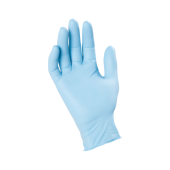The most valuable tools for construction workers are undeniably their hands, making it essential to safeguard them with the appropriate gloves. However, the vast array of options on the market can make it challenging for you to determine the perfect gloves for your unique use cases.
In this comprehensive guide to buying construction gloves, we will take a closer look at the different types of gloves used in the construction industry, including cut-resistant gloves, chemical-resistant gloves, impact-resistant gloves, and other options like waterproof gloves, disposable gloves, heat-resistant gloves, nitrile gloves, and leather gloves.
We will walk you through the unique features and benefits of each type of glove, as well as the different materials and levels of protection they offer. You’ll learn how to select the right gloves for your specific job site hazards and use cases, whether your workers are handling sharp objects, working with chemicals, or dealing with extreme temperatures.
Here are all the topics we will cover:
- Cut-resistant gloves for construction workers
- Chemical-resistant gloves for construction workers
- Impact-resistant gloves for construction workers
- Other considerations on safety gloves for construction workers

Cut-resistant gloves for construction workers
Cut-resistant gloves are an essential piece of personal protective equipment for construction workers handling sharp objects or materials such as glass, metal, or sharp-edged tools.
These gloves are designed to provide protection against cuts, punctures, and abrasions, helping to prevent injuries and accidents in the workplace.
Cut-resistant gloves are rated on a scale of 0 to 5, with 0 being the lowest level of cut resistance and 5 being the highest. This rating system helps users to choose the right gloves based on the level of protection needed for the job.
When selecting cut-resistant gloves for your construction workers, it’s important to consider several factors that directly impact their effectiveness and suitability.
- Assess the required level of cut resistance based on the tasks at hand. Low cut resistance might be suitable for tasks like handling insulation materials, while high cut resistance is necessary for working with sharp objects such as sheet metal or glass.
- Source the best material for your use cases. For instance, Kevlar gloves are more suitable for situations involving heat or flame exposure, such as welding or cutting operations. Dyneema gloves, on the other hand, offer different degrees of cut resistance and are more suitable for tasks like handling sharp-edged building materials or operating power saws.
- Consider the fit and comfort of the gloves. As they are meant for extended use, cut-resistant gloves with an ergonomic design, for instance, provide enhanced dexterity for intricate tasks like electrical wiring or carpentry work. Gloves with adjustable wrist closures or reinforcements in high-wear areas can ensure both comfort and durability during heavy-duty tasks, such as demolition or concrete drilling.
- Take into account the specific job tasks involved. For example, puncture-resistant gloves with added grip are ideal for handling nails or sharp debris, while gloves with impact protection can provide extra safety when working with heavy tools or machinery. It’s also crucial to check for any standards or certifications, such as the EN 388 rating, which measures the gloves’ protection against mechanical risks.
You can read more about choosing the right cut-resistant gloves for your workers in our comprehensive guide: How To Choose Cut-Resistant Gloves




Chemical-resistant gloves for construction workers
Chemical-resistant gloves are specifically designed to provide protection against hazardous chemicals and substances.
The European standard EN 374 sets the requirements for protective gloves against chemicals and microorganisms. This standard covers the permeation resistance of the gloves and the resistance to degradation by chemicals. Chemical-resistant gloves are tested against a range of chemicals, and they are classified according to their resistance to permeation. There are three levels of permeation resistance, and the gloves are labelled with the corresponding code letter.
The gloves are made from various materials, including natural rubber, neoprene, nitrile, and PVC. Natural rubber gloves provide good resistance to water-based solutions and acids, while neoprene gloves offer better resistance to oils and chemicals. Nitrile gloves are more suitable for handling harsh chemicals and solvents, while PVC gloves are better suited when handling strong acids and bases.
When sourcing chemical-resistant gloves for your construction workers, you must take into account the following:
- The specific chemicals being handled, such as concrete sealants, adhesives, or paint thinners.
- The duration of exposure and the temperature of the chemicals as these factors can affect glove performance. For instance, gloves designed for short-term exposure to mild chemicals might not be suitable for prolonged contact with high-temperature or highly corrosive substances like those encountered when working with certain waterproofing materials or chemical grouts.
- The thickness of the chemical-resistant gloves. Thicker gloves offer better protection against chemicals. For instance, workers handling concentrated acids during masonry restoration projects or dealing with chemical cleaning agents on construction sites may require gloves with a higher thickness for increased safety.
- The proper fit and comfort. Chemical-resistant gloves that are too tight or too loose can compromise safety and efficiency, especially when handling hazardous materials in European petrochemical industries or waste management facilities. Moreover, it’s essential to select gloves that are comfortable and allow for dexterity, ensuring workers can effectively perform tasks.

Impact-resistant gloves for construction workers
Construction workers are often exposed to hazards that can cause impact injuries, such as falling objects or equipment.
Impact-resistant gloves are designed to absorb and dissipate the force of these impacts, protecting the hands from injury. To ensure that impact-resistant gloves meet adequate safety standards, they are tested according to the European Standard EN 388:2016. This standard measures the resistance of gloves to abrasion, cut, tear, and puncture, as well as their impact resistance. The impact resistance is measured in joules, with a higher number indicating greater resistance to impact.
There are several types of impact-resistant gloves available, including gloves with padding or knuckle protection, as well as gloves made from materials like Kevlar or TPR (thermoplastic rubber). These gloves are designed to provide varying levels of protection, depending on the level of risk involved in a particular task.
When selecting impact-resistant gloves for construction workers, it is essential to consider the following factors:
- The type of work being done, as different tasks may require gloves with specific features. For instance, gloves with reinforced palms and finger protection might be necessary for workers handling heavy materials or using hand tools, while gloves with vibration-dampening features may be useful when operating power equipment like jackhammers or concrete breakers.
- The proper fit and comfort, as these factors directly impact worker efficiency and safety. Gloves with adjustable wrist closures or padded knuckles can offer both protection and comfort for tasks that involve repetitive impact or require a secure grip on tools and equipment.
Other considerations on safety gloves for construction workers
Construction workers face diverse challenges in their jobs, and therefore, you should always consider more options to ensure safety.
Here is a list of different safety gloves for construction workers designed for various purposes:
- Waterproof gloves. They are essential for construction workers dealing with wet conditions, such as working on flood protection projects or during rainy seasons.
- Disposable gloves. They are suitable for tasks requiring hygiene or frequent glove changes, such as cleaning up after a spill on a construction site. You can choose from various materials, including latex, nitrile, or vinyl, to find the perfect fit for your workforce.
- Heat-resistant gloves. They are essential for construction workers handling high-temperature materials, like welding or working with hot asphalt. These gloves are available in different materials, including leather, Kevlar, and aluminised materials, providing protection against burns or other injuries.
- Nitrile gloves. They are a popular choice for construction workers due to their durability. These gloves come in various sizes and thicknesses to suit different applications, such as working with adhesives, certain types of solvents, or paints.
- Leather gloves. They are an option for construction workers as they provide different degrees of protection against cuts and abrasions. They are available in different types of leather and come in various styles, such as driver and welding gloves, suitable for projects like assembling steel structures or heavy machinery operations.

Conclusion
All in all, buying the right construction gloves is crucial for ensuring worker safety and comfort.
Understanding the various types of gloves available, such as cut-resistant, chemical-resistant, and impact-resistant gloves, while also considering factors such as material, thickness, and size will help you make an informed decision and ensure the best fit and protection.
Next, you can visit our marketplace for an extensive selection of safety gloves for construction workers from Europeâs most-trusted suppliers that will cater to the unique needs of your settings and use cases. We’re here to help you make the best choices for the safety and success of your business!

















